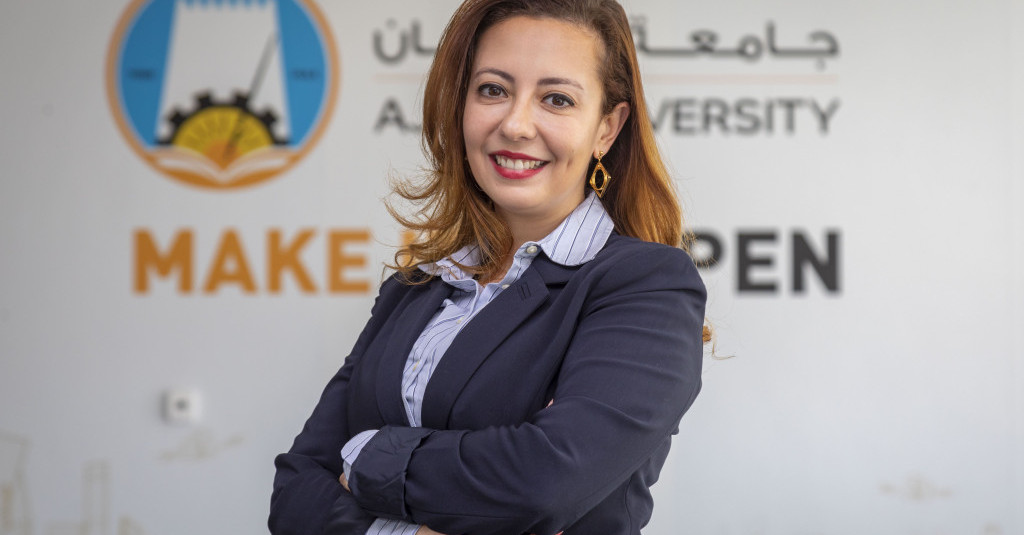Welcome to AU: New Faculty Member Dr. Dalia Hafez Talks about Her Interests in Design and Teaching

Meet Dr. Dalia Hafez, a designer, architect, academic, researcher, and phenomenologist who has a passion for environmental design! Dr. Dalia has a Ph.D. and master’s degree from the school of Architecture and Design (A+D), Virginia Tech, USA and is now a proud member of the Ajman University community!
Please tell us briefly about your educational background, academic experience, and journey so far.
I consider myself a designer, architect, academic, researcher, and phenomenologist who has a passion for environmental design. I believe in the interconnection between all design fields.
I received my Ph.D. and master’s degree from the school of Architecture and Design (A+D), Virginia Tech, USA. During my studies, I was honoured to receive the best student research award from the School of Architecture and Design at Virginia Tech twice. In addition, I was awarded the Richard Kelly Grant for lighting research excellence.
I had the privilege to teach various courses in both architecture and interior design fields at several universities in the US, Egypt, and the United Arab Emirates.
From 2017 to 2022, I collaborated with my colleagues to establish a new architecture program at a university in Dubai where I became the head of the architecture program.
How do you feel about joining Ajman University (AU) as a faculty member?
Ajman University is a well-established university with a long history and great facilities, which is a great platform where I can implement the skills and knowledge I acquired from my education and previous experience. I have always admired the values and the mission of AU; the diversity between students is a key asset of AU; it adds great value to the classroom and gives the instructor vitality to push the boundaries high with the support of the dynamic cultural diversity values brought into the classroom. In addition, AU puts countless efforts into research and values the researchers; such efforts are supported by the available facilities and labs, which encourages researchers to perform their best. In architecture and design creativity is a key aspect, I was pleased to learn that AU evaluates and appreciates creative work, exhibitions, expositions, and efforts outside the class.
What are some of the teaching/research areas you would be focusing on?
I have diverse research interests starting from exploring ways to enhance the relationship between the education and practice of architecture, and examining the daylighting dynamism which can create uncomfortable situations causing visual discomfort. In addition, I explored lighting conditions effect on behavioural decisions in transit stations, and wayfinding in interior spaces and outdoors. Also, I examined design aid for the visually impaired/elderly, and energy-saving technologies. In recent years, I have started exploring other research areas such as the effect of new autonomous technologies on a city's infrastructure and the living quality of smart city residents. In addition, I have recently started exploring other fields including designing for children with determination and human-centred design and its impact on design decisions and occupants’ comfort and well-being.
How would you define your teaching style?
I believe that the teaching style does not only depends on the nature of the teacher but also on the needs of the students. I would describe my teaching style as coaching, so I would describe my “coaching” style as being flexible and dynamic where students are involved in the process, aware of the steps, and when possible control the progression and give feedback on the outcomes. I am a strong believer that it is a two-way journey where the faculty learns from the students’ ideas, progression, and enthusiasm.
In your opinion, what can students do to get more out of their academic experience at University?
I trust students can always learn from their university journey by exploring opportunities within and beyond the university’s limits. These will highly enrich their experience and enhances their knowledge and also facilitate their professional experience. Some of these opportunities may include competitions, training, community services, activities, study abroad programs, internships, and volunteering. Those few academic years are the key basis to shaping their future, where their visions, backgrounds, and needs are to be fulfilled with experiences within and beyond academic boundaries.
What are your interests outside of work?
In addition to my love and passion for work, I am grateful for my small family and so blessed to be a mother of two amazing children. My family always supports me and is part of every step of my journey. I enjoy painting, handcrafting, playing piano, exercising, and spending time with my family and pets during spare and stressful times.